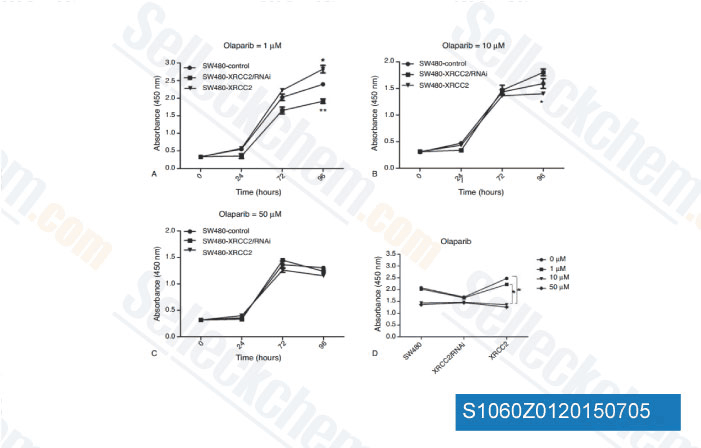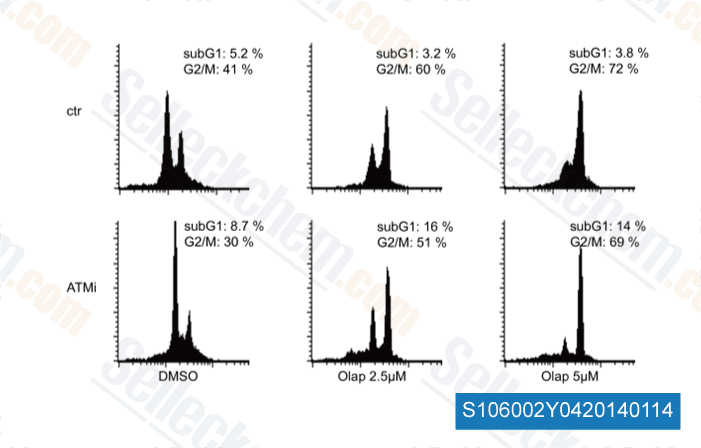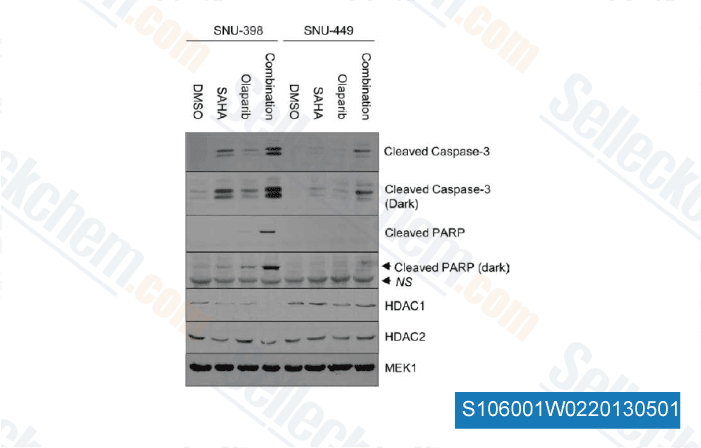|
Toll Free: (877) 796-6397 -- USA and Canada only -- |
Fax: +1-832-582-8590 Orders: +1-832-582-8158 |
Tech Support: +1-832-582-8158 Ext:3 Please provide your Order Number in the email. |
Technical Data
| Formula | C24H23FN4O3 |
|||
| Molecular Weight | 434.46 | CAS No. | 763113-22-0 | |
| Solubility (25°C)* | In vitro | DMSO | 43 mg/mL (98.97 mM) | |
| Water | Insoluble | |||
| Ethanol | Insoluble | |||
|
* <1 mg/ml means slightly soluble or insoluble. * Please note that Selleck tests the solubility of all compounds in-house, and the actual solubility may differ slightly from published values. This is normal and is due to slight batch-to-batch variations. * Room temperature shipping (Stability testing shows this product can be shipped without any cooling measures.) |
||||
Preparing Stock Solutions
Biological Activity
| Description | Olaparib (AZD2281, KU0059436) is a selective inhibitor of PARP1/2 with IC50 of 5 nM/1 nM in cell-free assays, 300-times less effective against tankyrase-1. Olaparib induces significant autophagy that is associated with mitophagy in cells with BRCA mutations. | ||||
|---|---|---|---|---|---|
| Targets |
|
||||
| In vitro | Olaparib would act against BRCA1 or BRCA2 mutations. Olaparib is not sensitive to tankyrase-1 (IC50 >1 μM). Olaparib could ablate the PARP-1 activity at concentrations of 30-100 nM in SW620 cells. Olaparib is hypersensitive to BRCA1-deficient cell lines (MDA-MB-463 and HCC1937), compared with BRCA1- and BRCA2-proficient cell lines (Hs578T, MDA-MB-231, and T47D). [1] Olaparib is strongly sensitive to KB2P cells due to suppression of base excision repair by PARP inhibition, which may result in the conversion of single-strand breaks to double-strand breaks during DNA replication, thus activating BRCA2-dependent recombination pathways. [2] |
||||
| In vivo | Olaparib (10 mg/kg, p.o.) in Combination significantly suppresses tumor growth in SW620 xenografts. [1] Olaparib shows great response to Brca1-/-;p53-/- mammary tumors (50 mg/kg i.p. per day), while no responses to HR-deficient Ecad-/-;p53-/- mammary tumors. Olaparib even does not show dose-limiting toxicity in tumor-bearing mice. [3] Olaparib has been used to treat with BRCA mutated tumors, such as ovarian, breast and prostate cancers. Moreover, Olaparib shows selectively inhibition to ATM (Ataxia Telangiectasia Mutated)-deficient tumor cells, which indicates to be a potential agent for treating ATM mutant lymphoid tumors. [4] |
||||
| Features | A potent PARP inhibitor (currently in late stage clinical trials). |
Protocol (from reference)
| Kinase Assay: |
|
|---|---|
| Cell Assay: |
|
| Animal Study: |
|
References
Customer Product Validation

-
Data from [Data independently produced by Cancer Res, 2014, 74(21), 5948-54]

-
Data from [Data independently produced by Medicine (Baltimore), 2014, 93(28), e294]

-
Data from [J Exp Clin Cancer Res, 2013, 32(1), 95]

-
Data from [Hepatology, 2012, 55, 1840-1851]
Selleck's Olaparib (AZD2281) has been cited by 1363 publications
| OGG1 and MUTYH repair activities promote telomeric 8-oxoguanine induced senescence in human fibroblasts [ Nat Commun, 2025, 16(1):893] | PubMed: 39837827 |
| CHD6 has poly(ADP-ribose)- and DNA-binding domains and regulates PARP1/2-trapping inhibitor sensitivity via abasic site repair [ Nat Commun, 2025, 16(1):1026] | PubMed: 39863586 |
| Uracil processing by SMUG1 in the absence of UNG triggers homologous recombination and selectively kills BRCA1/2-deficient tumors [ Mol Cell, 2025, S1097-2765(25)00098-X] | PubMed: 40010343 |
| Unraveling AURKB as a potential therapeutic target in pulmonary hypertension using integrated transcriptomic analysis and pre-clinical studies [ Cell Rep Med, 2025, 6(2):101964] | PubMed: 39933527 |
| Caspase 3 and caspase 7 promote cytoprotective autophagy and the DNA damage response during non-lethal stress conditions in human breast cancer cells [ PLoS Biol, 2025, 23(2):e3003034] | PubMed: 39982959 |
| TOPBP1 as a potential predictive biomarker for enhanced combinatorial efficacy of olaparib and AZD6738 in PDAC [ Cell Biosci, 2025, 15(1):17] | PubMed: 39920847 |
| SPHK1 enhances olaparib resistance in ovarian cancer through the NFκB/NRF2/ferroptosis pathway [ Cell Death Discov, 2025, 11(1):29] | PubMed: 39875359 |
| Enhancing PDAC therapy: Decitabine-olaparib synergy targets KRAS-dependent tumors [ iScience, 2025, 28(2):111842] | PubMed: 40008360 |
| Mechanism of Action and Interaction of Garlic Extract and Established Therapeutics in Prostate Cancer [ Int J Mol Sci, 2025, 26(4)1777] | PubMed: 40004239 |
| MK-8776 and Olaparib Combination Acts Synergistically in Hepatocellular Carcinoma Cells, Demonstrating Lack of Adverse Effects on Liver Tissues in Ovarian Cancer PDX Model [ Int J Mol Sci, 2025, 26(2)834] | PubMed: 39859548 |
RETURN POLICY
Selleck Chemical’s Unconditional Return Policy ensures a smooth online shopping experience for our customers. If you are in any way unsatisfied with your purchase, you may return any item(s) within 7 days of receiving it. In the event of product quality issues, either protocol related or product related problems, you may return any item(s) within 365 days from the original purchase date. Please follow the instructions below when returning products.
SHIPPING AND STORAGE
Selleck products are transported at room temperature. If you receive the product at room temperature, please rest assured, the Selleck Quality Inspection Department has conducted experiments to verify that the normal temperature placement of one month will not affect the biological activity of powder products. After collecting, please store the product according to the requirements described in the datasheet. Most Selleck products are stable under the recommended conditions.
NOT FOR HUMAN, VETERINARY DIAGNOSTIC OR THERAPEUTIC USE.
